stab MITSUBISHI COLT 2008 (in English) Owner's Guide
[x] Cancel search | Manufacturer: MITSUBISHI, Model Year: 2008, Model line: COLT, Model: MITSUBISHI COLT 2008Pages: 450, PDF Size: 14.57 MB
Page 327 of 450
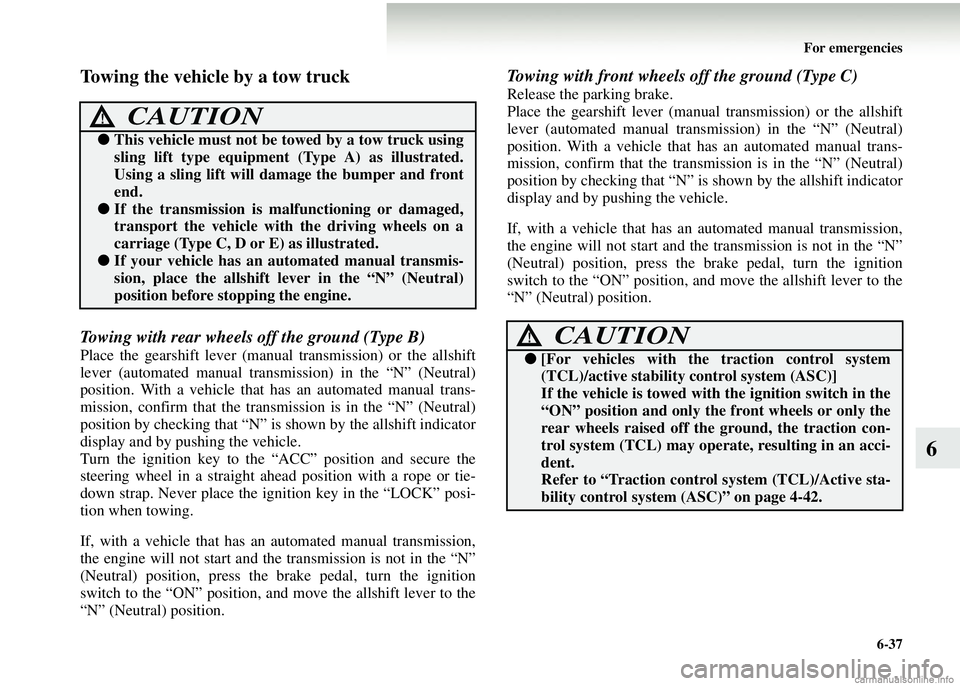
For emergencies6-37
6
Towing the vehicle by a tow truck
Towing with rear wheels off the ground (Type B)
Place the gearshift lever (manual transmission) or the allshift
lever (automated manual transm ission) in the “N” (Neutral)
position. With a vehicle that has an automated manual trans-
mission, confirm that the transm ission is in the “N” (Neutral)
position by checking that “N” is shown by the allshift indicator
display and by pushing the vehicle.
Turn the ignition key to the “ACC” position and secure the
steering wheel in a straight ah ead position with a rope or tie-
down strap. Never place the igni tion key in the “LOCK” posi-
tion when towing.
If, with a vehicle that has an automated manual transmission,
the engine will not start and the transmission is not in the “N”
(Neutral) position, press the brake pedal, turn the ignition
switch to the “ON” position, and move the allshift lever to the
“N” (Neutral) position.
Towing with front wheels off the ground (Type C)
Release the parking brake.
Place the gearshift lever (manual transmission) or the allshift
lever (automated manual transm ission) in the “N” (Neutral)
position. With a vehicle that has an automated manual trans-
mission, confirm that the transmi ssion is in the “N” (Neutral)
position by checking th at “N” is shown by the allshift indicator
display and by pushing the vehicle.
If, with a vehicle that has an automated manual transmission,
the engine will not start and th e transmission is not in the “N”
(Neutral) position, press the brake pedal, turn the ignition
switch to the “ON” position, and move the allshift lever to the
“N” (Neutral) position.
CAUTION!
● This vehicle must not be towed by a tow truck using
sling lift type equipment (Type A) as illustrated.
Using a sling lift will da mage the bumper and front
end.
● If the transmission is malfunctioning or damaged,
transport the vehicle with the driving wheels on a
carriage (Type C, D or E) as illustrated.
●If your vehicle has an automated manual transmis-
sion, place the a llshift lever in the “N” (Neutral)
position before stopping the engine.
CAUTION!
● [For vehicles with the traction control system
(TCL)/active stability control system (ASC)]
If the vehicle is towed with the ignition switch in the
“ON” position and only th e front wheels or only the
rear wheels raised off the ground, the traction con-
trol system (TCL) may operate, resulting in an acci-
dent.
Refer to “Traction control system (TCL)/Active sta-
bility control system (ASC)” on page 4-42.
Page 334 of 450
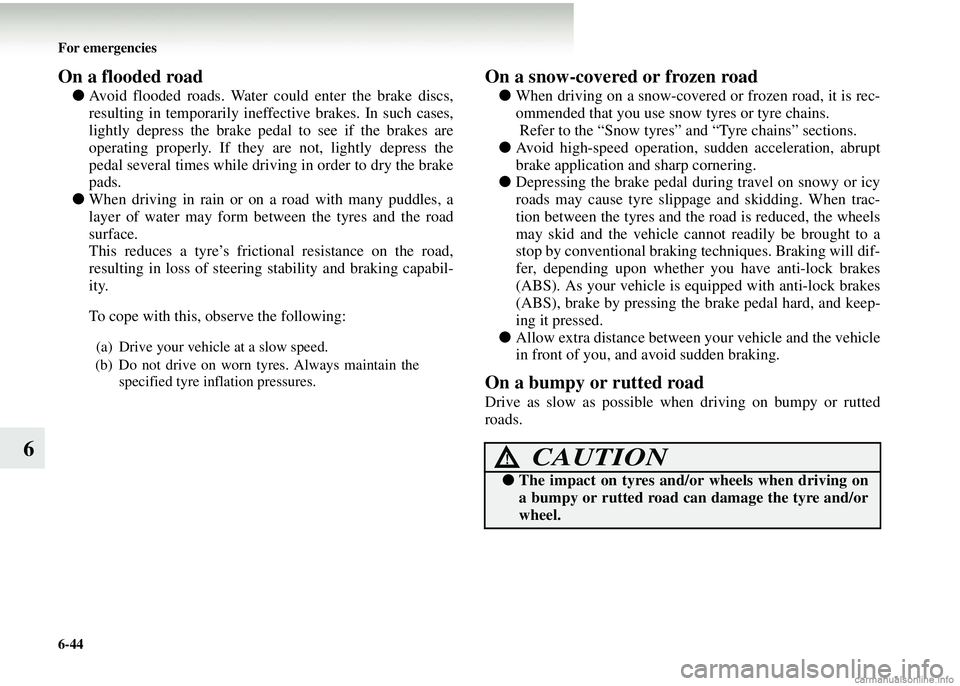
6-44 For emergencies
6
On a flooded road
●Avoid flooded roads. Water could enter the brake discs,
resulting in temporarily ineff ective brakes. In such cases,
lightly depress the brake pedal to see if the brakes are
operating properly. If they are not, lightly depress the
pedal several times while driving in order to dry the brake
pads.
● When driving in rain or on a road with many puddles, a
layer of water may form between the tyres and the road
surface.
This reduces a tyre’s frictional resistance on the road,
resulting in loss of steering stability and braking capabil-
ity.
To cope with this, observe the following:
On a snow-covered or frozen road
●When driving on a snow-covered or frozen road, it is rec-
ommended that you use snow tyres or tyre chains.
Refer to the “Snow tyres” and “Tyre chains” sections.
● Avoid high-speed operation, sudden acceleration, abrupt
brake application and sharp cornering.
● Depressing the brake pedal during travel on snowy or icy
roads may cause tyre slippage and skidding. When trac-
tion between the tyres and the road is reduced, the wheels
may skid and the vehicle cannot readily be brought to a
stop by conventional braking techniques. Braking will dif-
fer, depending upon whether you have anti-lock brakes
(ABS). As your vehicle is equipped with anti-lock brakes
(ABS), brake by pressing th e brake pedal hard, and keep-
ing it pressed.
● Allow extra distance between yo ur vehicle and the vehicle
in front of you, and avoid sudden braking.
On a bumpy or rutted road
Drive as slow as possible when driving on bumpy or rutted
roads.
(a) Drive your vehicle at a slow speed.
(b) Do not drive on worn tyres. Always maintain the specified tyre inflation pressures.
CAUTION!
●The impact on tyres and/ or wheels when driving on
a bumpy or rutted road can damage the tyre and/or
wheel.
Page 357 of 450
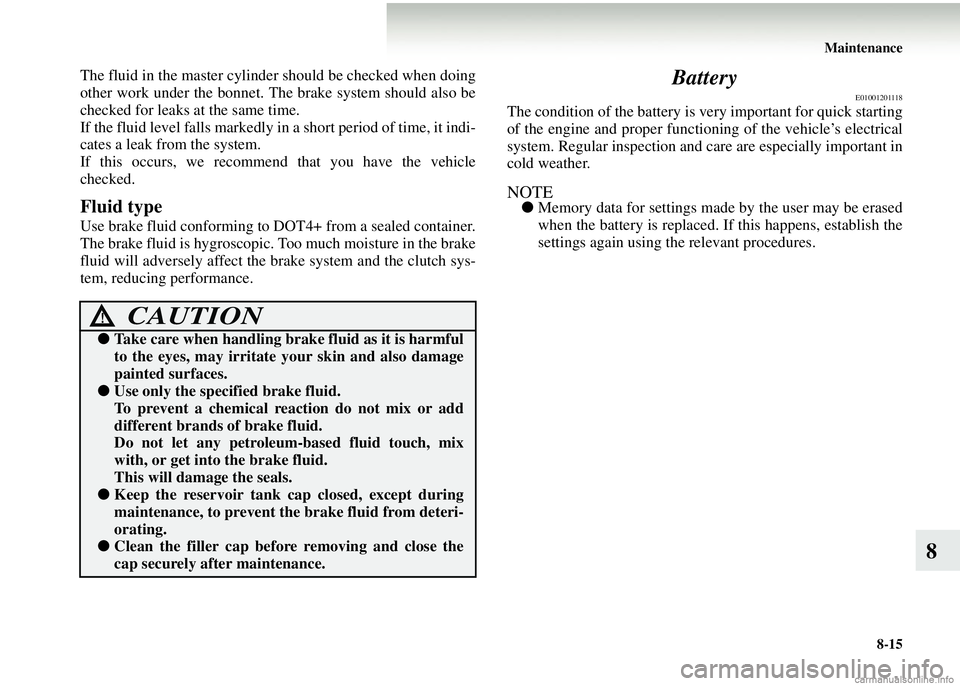
Maintenance8-15
8
The fluid in the master cylinder should be checked when doing
other work under the bonnet. Th e brake system should also be
checked for leaks at the same time.
If the fluid level falls markedly in a short period of time, it indi-
cates a leak from the system.
If this occurs, we recommen d that you have the vehicle
checked.
Fluid type
Use brake fluid conforming to DOT4+ from a sealed container.
The brake fluid is hygroscopic. Too much moisture in the brake
fluid will adversely affect the br ake system and the clutch sys-
tem, reducing performance.
Battery
E01001201118
The condition of the battery is very important for quick starting
of the engine and proper functioning of the vehicle’s electrical
system. Regular inspection and care are especially important in
cold weather.
NOTE● Memory data for settings made by the user may be erased
when the battery is replaced. If this happens, establish the
settings again using the relevant procedures.
CAUTION!
● Take care when handling brake fluid as it is harmful
to the eyes, may irritate your skin and also damage
painted surfaces.
●Use only the speci fied brake fluid.
To prevent a chemical reaction do not mix or add
different brands of brake fluid.
Do not let any petroleum-based fluid touch, mix
with, or get into the brake fluid.
This will damage the seals.
● Keep the reservoir tank cap closed, except during
maintenance, to prevent th e brake fluid from deteri-
orating.
● Clean the filler cap before removing and close the
cap securely after maintenance.
Page 364 of 450

8-22 Maintenance
8
Snow tyresE01002000549
The use of snow tyres is recommended for driving on snow and
ice. To preserve driving stability, mount snow tyres of the same
size and tread pattern on all four wheels.
Snow tyres worn more than 50 % are no longer suitable for use
as snow tyres.
Snow tyres which do not meet the specifications must not be
used.
NOTE● The laws and regulations concerning snow tyres (driving
speed, required use, type, etc.) vary. Find out and comply
with the laws and regulations in the area you intend to
drive in.
● If flange nuts are used on your vehicle, change to tapered
nuts when steel wheels are used.
Tyre chains E01002101039
If tyre chains have to be used, ensure that they are fitted only
on the drive wheels (front).
Use only tyre chains which are designed for use with the tyres
mounted on the vehicle: use of the incorrect size or type of
chain could result in damage to the vehicle body.
Before fitting tyre chains, we recommend that you consult a
MITSUBISHI MOTORS Authorized Service Point. The Max.
chain height is as follows.
CAUTION!
● If the tyres have arrows (A) indicating the correct
direction of rotation, swap the front and rear wheels
on the left hand side of th e vehicle and the front and
rear wheels on the right hand side of the vehicle sep-
arately. Keep each tyre on its original side of the
vehicle. When fitting the tyres, make sure the
arrows point in the dir ection in which the wheels
will turn when the vehicle moves forward. Any tyre
whose arrow points in the wrong direction will not
perform to its full potential.
CAUTION!
● Avoid the combined use of different types of tyres.
This can affect driving safety.
Front
CAUTION!
●Observe the permissible maximum speed for your
snow tyres and the legal speed limit.
Page 437 of 450
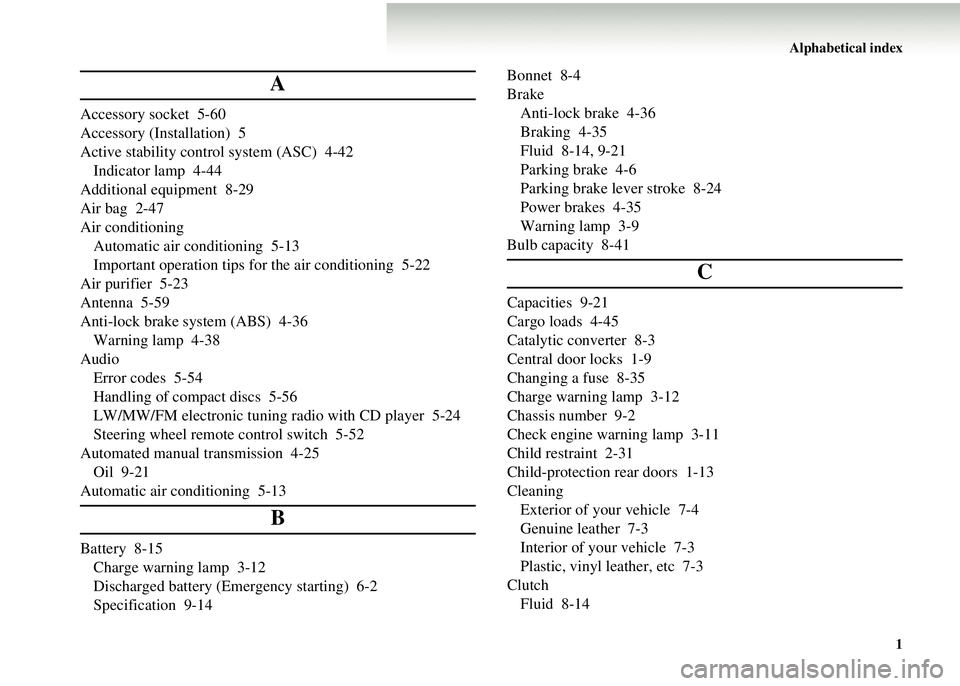
Alphabetical index1
A
Accessory socket 5-60
Accessory (Installation) 5
Active stability control system (ASC) 4-42Indicator lamp 4-44
Additional equipment 8-29
Air bag 2-47
Air conditioning Automatic air conditioning 5-13
Important operation tips for the air conditioning 5-22
Air purifier 5-23
Antenna 5-59
Anti-lock brake system (ABS) 4-36 Warning lamp 4-38
Audio Error codes 5-54
Handling of compact discs 5-56
LW/MW/FM electronic tuning radio with CD player 5-24
Steering wheel remote control switch 5-52
Automated manual transmission 4-25 Oil 9-21
Automatic air conditioning 5-13
B
Battery 8-15 Charge warning lamp 3-12
Discharged battery (Emergency starting) 6-2
Specification 9-14 Bonnet 8-4
Brake
Anti-lock brake 4-36
Braking 4-35
Fluid 8-14, 9-21
Parking brake 4-6
Parking brake lever stroke 8-24
Power brakes 4-35
Warning lamp 3-9
Bulb capacity 8-41
C
Capacities 9-21
Cargo loads 4-45
Catalytic converter 8-3
Central door locks 1-9
Changing a fuse 8-35
Charge warning lamp 3-12
Chassis number 9-2
Check engine warning lamp 3-11
Child restraint 2-31
Child-protection rear doors 1-13
Cleaning Exterior of your vehicle 7-4
Genuine leather 7-3
Interior of your vehicle 7-3
Plastic, vinyl leather, etc 7-3
Clutch Fluid 8-14
Page 441 of 450
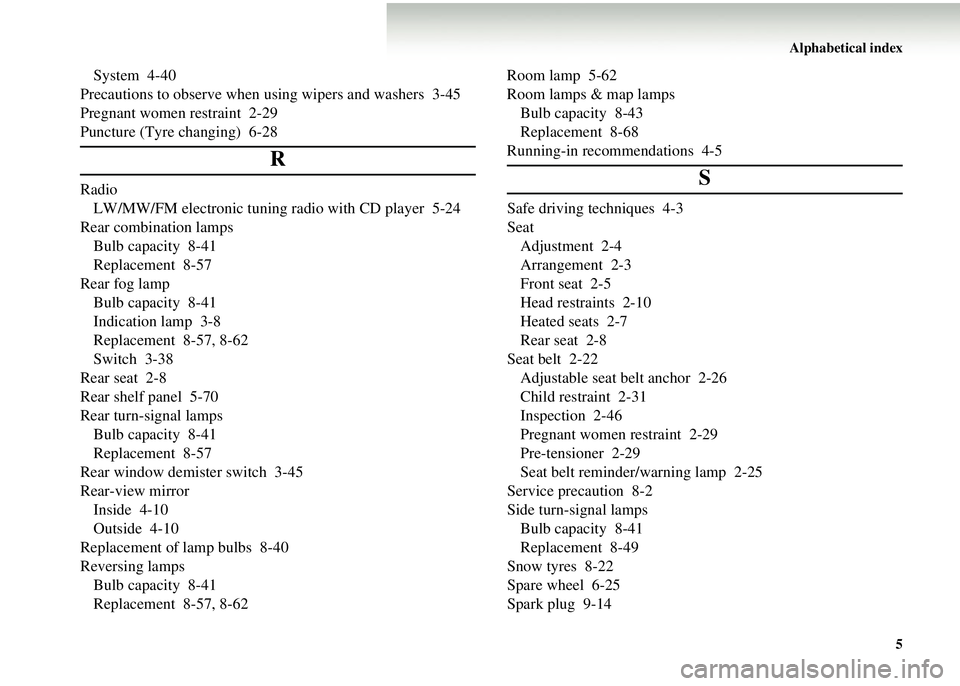
Alphabetical index5
System 4-40
Precautions to observe when using wipers and washers 3-45
Pregnant women restraint 2-29
Puncture (Tyre changing) 6-28
R
Radio LW/MW/FM electronic tuning radio with CD player 5-24
Rear combination lamps Bulb capacity 8-41
Replacement 8-57
Rear fog lamp Bulb capacity 8-41
Indication lamp 3-8
Replacement 8-57, 8-62
Switch 3-38
Rear seat 2-8
Rear shelf panel 5-70
Rear turn-signal lamps Bulb capacity 8-41
Replacement 8-57
Rear window demister switch 3-45
Rear-view mirror Inside 4-10
Outside 4-10
Replacement of lamp bulbs 8-40
Reversing lamps Bulb capacity 8-41
Replacement 8-57, 8-62 Room lamp 5-62
Room lamps & map lamps
Bulb capacity 8-43
Replacement 8-68
Running-in recommendations 4-5S
Safe driving techniques 4-3
Seat Adjustment 2-4
Arrangement 2-3
Front seat 2-5
Head restraints 2-10
Heated seats 2-7
Rear seat 2-8
Seat belt 2-22 Adjustable seat belt anchor 2-26
Child restraint 2-31
Inspection 2-46
Pregnant women restraint 2-29
Pre-tensioner 2-29
Seat belt reminder/warning lamp 2-25
Service precaution 8-2
Side turn-signal lamps Bulb capacity 8-41
Replacement 8-49
Snow tyres 8-22
Spare wheel 6-25
Spark plug 9-14